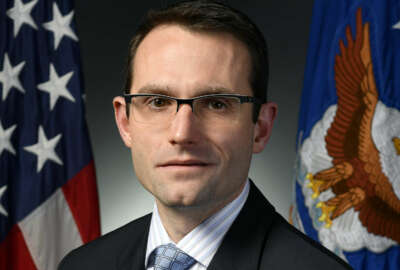
Federal contractors try to support customers, balance compliance
It's been a topsy turvy year for federal contracting. All the while contractors are figuring out how to support their customers while also responding to new...
Best listening experience is on Chrome, Firefox or Safari. Subscribe to Federal Drive’s daily audio interviews on Apple Podcasts or PodcastOne.
It’s been a topsy turvy year for federal contracting. The acquisition system had to adapt to telework and rapidly respond to new pandemic-related demands, all the while contractors are figuring out how to support their customers while also responding to new compliance demands. Deniece Peterson is director for Federal Market Analysis at Deltek, and she spoke with Federal Drive with Tom Temin about what the data tells us about 2020 and going into 2021.
Interview transcript:
Deniece Peterson: So far we’re kind of seeing that the number of opportunities are kind of on pace with what we saw last year. I think what helped a lot is the mainly successful transition to teleworking in the government. We were tracking kind of opportunities which were COVID response related, and how quickly those were happening, as well as those that were not COVID related but were being impacted by that. And so most of what we saw was delays and industry days, some delays in solicitation releases, changes to processes and things like that, but we haven’t yet seen a significant hit as far as what the opportunity landscape looks like in terms of the pace. Now, obviously, the nature of what those opportunities are could start to change moving into 2021, depending on what that budget looks like, if there is any shuffling of priorities within agencies. But I think, I focus on IT obviously, and for IT I think it’s it’s fairly promising because agencies were already on this modernization track, but I think with COVID and teleworking and the need for data analytics, and all these cyber and cloud and all that, COVID really put a spotlight on the need for those things. So we we anticipate seeing more opportunities around those areas that already had some momentum behind them to begin with.
Jared Serbu: I think that’s a fair expectation for sure in 2021, but how many of those opportunities directly related to COVID and telework have popped up in 2020, from what we can tell?
Deniece Peterson: The number of opportunities, I would have to go back and look at that data. I look at dollars more than count, but there’s been about $22 billion in COVID in total, and about 2.4 of that has been for IT. A fraction of that has been directed to IT, but looking at the nature of that spend, there’s been some kind of pockets within that as well. So a lot of it was for laptops and software unify communications to get federal employees teleworking. And then software with to support analytics and health research and things like that. So in terms of dollars, I mean, it’s obviously been an extra boost for IT contractors and all contractors really that are in IT, professional services, medical equipment, things like that. But the bulk of it has been on kind of the medical, vaccine development and R&D and things like that.
Jared Serbu: And then zooming out considering not just COVID since you do focus on IT, what are the overall growth areas that you see in the IT market at the moment?
Deniece Peterson: Well interesting, really, as I said before, the growth areas that we saw before, have been amplified by COVID. So things like cloud computing, cybersecurity, and what I’ll call kind of AI and machine learning powered big data. So analytics and automation, AI, those kind of things I put in kind of that that big, AI powered, big data bucket. So all those things were priorities before COVID. The need has only been amplified because of COVID. It kind of exposed not just the vulnerabilities, right, that’s a big deal with cyber, but also highlighted the success models that we saw with agencies that had already invested in cloud computing, and how much easier it was for them to make that transition under these extraordinary circumstances. So I think we will continue to see growth in those areas because there was already momentum. The needs highlighted by COVID raised it to the level of Congress and it put kind of a very significant spotlight on it from the powers that be that maybe weren’t in the weeds too much on federal IT before.
Jared Serbu: Aside from what agencies are spending on, are you seeing any notable difference in how they’re spending, in other words that this sort of contract methodologies and vehicles that they’re using?
Deniece Peterson: I think COVID allowed for additional acquisition flexibilities. And similar with technology, I think the acquisition flexibilities that really helped with the response are those that had some momentum behind them, the biggest one obviously being other transaction authority. We were already seeing some pretty significant growth there. So, across the board, about 80, 85% increase just from FYI 18 to 19. And particularly for IT, a lot of growth there. Back in FYI. 17 I think it was, it was about $80 million of those OTA obligations refer IT related prototyping activities. And for FY 19, it’s about $670 million, which in the scope of things, it’s kind of pocket change for the government, but that’s over a 700% increase. And so we’re seeing things like AI and cloud and cyber being procured under OTAs. And so that was already happening. We had the CARES Act kind of remove some of the caps and barriers around that. So that’s something else that’s being leveraged for the response. Another thing we’re looking at is commercial solutions openings. CSOs which agencies, they’re not exactly like OTAs but agencies can use those to get access to innovative commercial solutions, or new capabilities to close technology gaps. And so there was already a pilot program set up that DoD and GSA were working on, but I think given kind of the need for access to innovative solutions, especially quickly, at the pace of technology change, those options are looking very attractive compared to kind of the lengthy traditional federal acquisition process. One thing I want to mention as well is when we talk about how they’re contracting, using technology to speed acquisition process is another thing to watch. So they’re using things like robotic process automation, and AI and machine learning to just help procure things faster through the traditional avenues.
Jared Serbu: And another avenue that’s just popped up is the GSA e-marketplace initiative, which is just up and running now on a pilot basis. Obviously too early to tell what kind of influence that’s going to have — but what are you going to be watching for specifically there?
Deniece Peterson: Well I think they’re looking at the various models for that. There’s a lot of pressure on that, based on the expectations from Congress as far as what would the impact be on competition, especially small business. Will it speed procurement, what kind of oversight because it’s going to be kind of the smaller ticket items that purchase card holders can use, and just making sure there’s enough oversight there. So those are kind of the things particularly with the small business that I think there’ll be a lot of pressure to make sure that those businesses, especially now because they’re the hardest hit under this pandemic, to make sure that there’s still opportunity there for small business.
Copyright © 2025 Federal News Network. All rights reserved. This website is not intended for users located within the European Economic Area.
Tom Temin is host of the Federal Drive and has been providing insight on federal technology and management issues for more than 30 years.
Follow @tteminWFED
Related Stories





